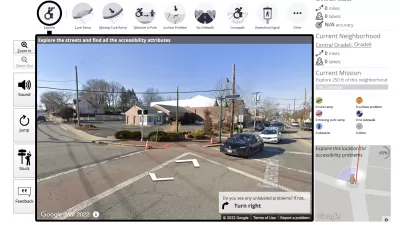Every person is unique. Every day is unique. Every trip is unique. As a result, an efficient and equitable transportation system must be diverse, so people can choose the best option for each trip. For example, today you might prefer to walk or bicycle, but tomorrow find it best to use public transit or drive.
Every person is unique. Every day is unique. Every trip is
unique. As a result, an efficient and equitable transportation system must be diverse, so people can choose the best
option for each trip. For example, today you might prefer to walk or bicycle,
but tomorrow find it best to use public transit or drive.
There are many aspects of transportation diversity (also called "transportation choice" or "transportation options"). It can
include various modes (walking, cycling, ridesharing and public transit),
pricing options (such as the ability to rent a vehicle by the hour, or pay for
insurance by the mile), services (taxis, carsharing, bike rentals, store
delivery, etc.), service quality (such as premium public
transportation services, so travelers can choose to pay extra for additional amenities
such as on-board refreshments and Wi-Fi), and locations (such as being able to
find an affordable home in a transit-oriented neighborhood, not just in an automobile-dependent suburb).
One benefit of transportation diversity is what economists call this Option Value, which refers to
the value that consumers place on having an option available, even if
they do not currently use it. For example, many people value having public transit
service in their community because they
might need it in the future. A diverse transportation system is resilient, allowing people to
respond efficiently to unexpected change. For example, a multi-modal
transportation system (where people can walk, bicycle, ride public
transportation as well drive) allows people to maintain mobility even
if they are disabled and unable to drive, if fuel prices increase making
automobile travel expensive, or if an accident prevents driving on a particular
roadway.
The value of transportation diversity is reflected in many ways.
Residents of communities with multi-modal transport systems tend to experience
less traffic congestion, lower accident rates, spend a smaller portion of their
household budget on transportation, exercise more and are less likely to be
overweight than residents of automobile-dependent communities.
A recent study by the U.S. Congressional Budget Office, Effects
of Gasoline Prices on Driving Behavior and Vehicle Markets measured consumer
responses to rising fuel prices. It found that when fuel prices increase motorists
reduce traffic speeds, purchase more fuel efficient vehicles, drive less, and
if they have access to high quality alternatives, will shift modes. The
researchers measured Southern California
freeway traffic volumes. They found that vehicle trips declined on freeways
that had parallel rail transit service and transit ridership on the
corresponding rail systems increased by a commensurate amount, but no such
traffic reductions were found on freeways that lack rail transit service. Overall,
a 10% increase in fuel prices reduces fuel consumption by 0.6% in the short run
and 4% over the long run.
Other
studies find similar effects with regard to traffic congestion. Highways
with parallel high quality, grade separated public transit service tend to
experience less traffic congestion than highways that lack alternatives,
because as congestion increases a portion of travelers shift mode, lowering the
point of congestion equilibrium. Congestion never disappears (that would
require road pricing), but it is significantly lower than what would otherwise
occur.
Travelers who lack suitable options are trapped.
They are forced into modes and destinations that do not really reflect
their preferences. For example, if walking and cycling conditions are
poor and public transit service is inferior, commuters will continue to
drive even if traffic congestion is terrible and fuel prices surge, but
if better options exist they can choose the combination that best meets
their needs. This makes consumers better off overall.
This has important implications for all sorts of planning
decisions. Over the last century we have developed an excellent roadway system
that allows motorists to drive nearly everywhere with reasonable comfort and
convenience, except under urban-peak conditions when they face congestion. It
now makes sense to diversity our transport system so travelers have viable
alternatives, particularly under urban-peak conditions. This will allow
individuals to choose the option that best meets their needs for each trip.
This is not simply a debate between motorists and
non-motorists. Drivers have every reason to support alternative modes because a
more diversified transportation system reduces their traffic and parking
congestion, accident risk, pollution exposure, and their need to chauffeur
non-driving family and friends. It also offers options that they may eventually
find useful.
Unfortunately, conventional planning ignores most benefits
of transportation diversity. Conventional traffic models evaluate transport
system efficiency based primarily on travel speeds, and so they assume that travel
shifted from automobile to slower modes (such as walking, cycling and public
transit) makes travelers worse off. This assumption is wrong. If consumers
shift mode in response to a positive incentive, such as improved travel options
or a financial reward such as parking
cash out, they must be better off overall, taking into account all of their
costs and benefits, or they wouldn't make the shift.
To their credit, many planning professionals and public
officials support efforts to improve transportation system diversity much more
than is justified by their own economic models. They know intuitively that
there are significant benefits to a multi-modal transportation system which are
difficult to measure. However, the do this despite rather than with the support
of existing transportation models and evaluation tools.
In a typical community, 20-30% of the population has
significant constraints on their ability to drive due to age, disability, low
income or some other problem. It therefore makes sense that anybody involved in
transportation decision-making (planners, city councilors, transportation agency
executives) should be required to spend 20-30% of their days without being
allowed to drive, so they can experience the transportation system from a
non-drivers' perspective. Hopefully, that will help decision-makers understand
the value of transportation diversity, and help them identify new ways to
create a truly integrated transport system.
For more information see:
Todd Litman
(2001), "You Can Get There From Here: Evaluating Transportation Choice," Transportation
Research Record 1756, Transportation Research Board, pp. 32-41; at www.vtpi.org/choice.pdf.
K.H. Schaeffer
and Elliot Sclar (1980), Access for All, Columbia
University Press (New York).

Alabama: Trump Terminates Settlements for Black Communities Harmed By Raw Sewage
Trump deemed the landmark civil rights agreement “illegal DEI and environmental justice policy.”

Planetizen Federal Action Tracker
A weekly monitor of how Trump’s orders and actions are impacting planners and planning in America.

The 120 Year Old Tiny Home Villages That Sheltered San Francisco’s Earthquake Refugees
More than a century ago, San Francisco mobilized to house thousands of residents displaced by the 1906 earthquake. Could their strategy offer a model for the present?

LA’s Tree Emergency Goes Beyond Vandalism
After a vandal destroyed dozens of downtown LA trees, Mayor Karen Bass vowed to replace them. Days later, she slashed the city’s tree budget.

Sacramento Leads Nation With Bus-Mounted Bike Lane Enforcement Cameras
The city is the first to use its bus-mounted traffic enforcement system to cite drivers who park or drive in bike lanes.

Seattle Voters Approve Social Housing Referendum
Voters approved a corporate tax to fund the city’s housing authority despite an opposition campaign funded by Amazon and Microsoft.
Urban Design for Planners 1: Software Tools
This six-course series explores essential urban design concepts using open source software and equips planners with the tools they need to participate fully in the urban design process.
Planning for Universal Design
Learn the tools for implementing Universal Design in planning regulations.
Ada County Highway District
Clanton & Associates, Inc.
Jessamine County Fiscal Court
Institute for Housing and Urban Development Studies (IHS)
City of Grandview
Harvard GSD Executive Education
Toledo-Lucas County Plan Commissions
Salt Lake City
NYU Wagner Graduate School of Public Service





























